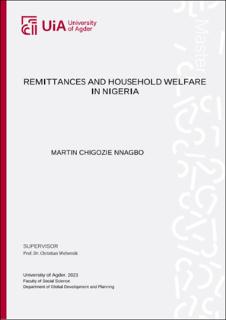| dc.description.abstract | Remittance represents an injection into an economy and one of the leading recipients of remittances in Africa is Nigeria. Remittance which has evolved into one of Nigeria’s primary external financial sources is particularly important for households in developing countries, as they often lack access to other sources of income and resources. Despite being one of Africa’s top remittance-receiving nations, welfare statistics show that the nation has the worst welfare outcomes across the globe. This is worrying given that achieving many of the Sustainable Development Goals (SDGs) by 2030 is contingent on improving household welfare. Given this background, this study uncovers the influence of remittances on household welfare in Nigeria. To add to the literature, this study employed nationally representative household-level data. Furthermore, the study interacted with remittance with rural and urban residents to ascertain if it amplifies or weakens the effect of remittance on household food and non-food consumption.
Additionally, the study introduced an interaction model which seeks to ascertain whether the employment status of the remittance recipient amplifies or weakens the impact of remittance on household earning power. The result obtained showed that diaspora remittance has a significant positive impact on household food consumption. The interactive effect of remittance with spatial locations (urban and rural residency) further increases food consumption. However, the amplifying effect is higher when remittance interacts with rural residency. This indicates that rural dwellers use more remittance for food consumption than urban dwellers. Relatedly, the study revealed that remittance increases non-food consumption. The interaction model highlights the amplifying effect of spatial location on the interaction between remittance and household non-food consumption. However, the amplifying effect is higher when remittance interacts with urban residency suggesting that those in the urban areas will more likely spend their remittance on non-food consumption than those in the rural area.
Lastly, the study also found that remittance inflow has a significant positive impact on the earning capabilities of households. When remittances interact with employment status, the study highlighted that both employed and unemployed persons increase their earning power through the receipt of remittance, the impact is higher for persons who are not employed. This is intuitive since the utility of additional money received is higher for low-income persons than the high-income persons. The study suggests that reducing the cost of remittance transfers and enhancing the financial infrastructure in remittance-recipient nations would be crucial tools for increasing remittance inflows through authorized channels. | |
